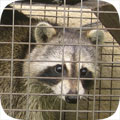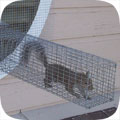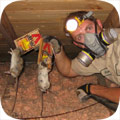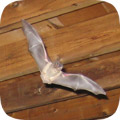- cortland@wildlifeanimalcontrol.com
Call 24/7 for a free quote:
607-353-6330
Cortland Wildlife Animal Control
Professional Wildlife Removal Company Servicing Cortland, NY
If you have a problem with wildlife in your Cortland home, your best option is to hire a company that specializes in New York wildlife removal only. This is a specialty business, and regular pest control companies do not use the proper techniques to solve animal problems. I have spent many years reviewing New York and Cortland, and I recommend the following:
Fur and Feathers Wildlife Control
Cell Phone: 607-353-6330
NOTE: If you have a dog or cat problem, call Cortland County Animal Services: (607) 753-8885

Fur and Feathers Wildlife Control specializes primarily in removing animals from attics of homes and buildings - this includes squirrels in attics, raccoons, and rats or mice in homes. New York also has a documented problem with
bats in buildings, and Fur and Feathers Wildlife Control is specially trained in bat removal. They also perform general wildlife trapping services, such as the capture and removal of skunks or opossums on the
property. Call 607-353-6330 to discuss your critter problem and schedule a same-day or next-day appointment. Click here to learn more about what prices we charge in 2020.
When hiring a company to solve your wild animal problem, you want these features:
- Specializes in wildlife removal, not pest control
- Fully New York and Cortland County licensed and insured
- Works 7 days per week (critters don't take weekends off)
- Performs full building inspections: enters and inspects attic
- Performs exclusion repairs, with guarantee against animal re-entry
- Offers cleanup of biohazardous wildlife waste
Fur and Feathers Wildlife Control is a full-service Cortland wildlife removal company. This is very different from a regular Cortland pest control company. The pest control companies spray poison to kill insects. This is not at all
similar to wildlife removal. Fur and Feathers Wildlife Control performs a full inspection of the home or property, and determines why the animal(s) are there, and if inside a building, how the animals got inside. All
animals (including rodents) are trapped and removed, or if possible, removed from the building using special exclusion devices. Once the animals are gone, preventative repairs are essential, and
cleanup is sometimes recommended.
 Cortland wildlife trapping - it's not as simple as it may seem. It's illegal in New York to trap without a license. Trap type is very important and there are many different types, bait is somewhat relevant, trap placement
is vital, and there are dozens of small things that are very important to know.
Safety is a concern. Then once the animal is trapped, it must be removed and dealt with in the proper manner according to New York law. We offer Cortland raccoon removal. Read more about how to get rid of raccoons.
Cortland wildlife trapping - it's not as simple as it may seem. It's illegal in New York to trap without a license. Trap type is very important and there are many different types, bait is somewhat relevant, trap placement
is vital, and there are dozens of small things that are very important to know.
Safety is a concern. Then once the animal is trapped, it must be removed and dealt with in the proper manner according to New York law. We offer Cortland raccoon removal. Read more about how to get rid of raccoons.
 Animals in attics - this is our specialty at Fur and Feathers Wildlife Control. Many types of animals like to live in attics. This includes squirrels, raccoons, rats, mice, bats, birds, and even possums. Critters like to go into attics for a safe place to live
and raise their young. Removing animals from attics is very complex work, partly because of the presence of baby animals. If you need Cortland squirrel removal, we can remove all the squirrels from your attic, and seal out any future ones. Read more about how to get rid of squirrels.
Animals in attics - this is our specialty at Fur and Feathers Wildlife Control. Many types of animals like to live in attics. This includes squirrels, raccoons, rats, mice, bats, birds, and even possums. Critters like to go into attics for a safe place to live
and raise their young. Removing animals from attics is very complex work, partly because of the presence of baby animals. If you need Cortland squirrel removal, we can remove all the squirrels from your attic, and seal out any future ones. Read more about how to get rid of squirrels.
 Rodent control must be done in a very specific way. First off, the most important thing is that all the openings that rats and mice can use to enter a house be sealed. Then all the rodents must be physically trapped and removed.
Never, ever use poison! Most Cortland exterminators will just use this lazy poison technique to kill rodents, and it causes more harm than good - dead stinky rats, and it doesn't solve the problem. Call us for correct Cortland rat removal. Read more about how to get rid of rats.
Rodent control must be done in a very specific way. First off, the most important thing is that all the openings that rats and mice can use to enter a house be sealed. Then all the rodents must be physically trapped and removed.
Never, ever use poison! Most Cortland exterminators will just use this lazy poison technique to kill rodents, and it causes more harm than good - dead stinky rats, and it doesn't solve the problem. Call us for correct Cortland rat removal. Read more about how to get rid of rats.
 Bat removal is a highly specialized task. New York is known to have colonizing bats who often live in buildings. Bats love attics. If not removed, the colony can grow to a very large size over the years. The bat droppings are often corrosive and
cause health risks. The same goes for bird droppings on or in buildings. We perform Cortland pigeon removal and bird control. But our specialty is Cortland bat removal. We remove 100% of the bat colony and seal the building so that it's totally bat-proof. Read more about how to get rid of bats.
Bat removal is a highly specialized task. New York is known to have colonizing bats who often live in buildings. Bats love attics. If not removed, the colony can grow to a very large size over the years. The bat droppings are often corrosive and
cause health risks. The same goes for bird droppings on or in buildings. We perform Cortland pigeon removal and bird control. But our specialty is Cortland bat removal. We remove 100% of the bat colony and seal the building so that it's totally bat-proof. Read more about how to get rid of bats.
 If you have animals inside a house, no job is complete without proper exclusion repairs. If you simply hire a Cortland trapper who only removes the critters, then the problem will return. You need to hire a Cortland wildlife control company that identifies 100% of the animal entry points
into your building, and seals them shut with professional repairs. In addition, in many cases animals have left waste or contamination behind, and you'll want a company that can provide professional cleaning services. Fur and Feathers Wildlife Control does both.
If you have animals inside a house, no job is complete without proper exclusion repairs. If you simply hire a Cortland trapper who only removes the critters, then the problem will return. You need to hire a Cortland wildlife control company that identifies 100% of the animal entry points
into your building, and seals them shut with professional repairs. In addition, in many cases animals have left waste or contamination behind, and you'll want a company that can provide professional cleaning services. Fur and Feathers Wildlife Control does both.
The above are just some of the services offered by Fur and Feathers Wildlife Control. We also trap and remove animals that destroy lawns, such as moles, or digging animals. Sometimes animals like opossums will live under buildings, steal pet food, raid garbage cans, etc.
Read about how to get rid of opossums. Skunks commonly live under sheds or decks, and set up a den. We can trap and remove them without them spraying. Read about how to get rid of skunks. Fur and Feathers Wildlife Control
also provides dead animal removal in Cortland. If you need help with any other wildlife conflict, from a fox, beaver, groundhog, or any other critter, we can solve it. We also do Cortland snake removal - most of the snakes in New York are not venomous, but
call us if you want safe removal, or read about how to get rid of snakes in Cortland. And remember, we are a private business, not Cortland County Animal Control Services, so if you have a dog or cat problem, call the County at (607) 753-8885.
Cortland County animal services does not handle any wildlife issues.
Fur and Feathers Wildlife Control: 607-353-6330
Cortland Pricing Info For Year 2020
 Every wildlife removal situation is different, from the species of animals involved, the location of the animal inside a house or outside, the extent of repairs or cleanup, etc. It's impossible to give one-size-fits-all prices. Examples MIGHT include:
Every wildlife removal situation is different, from the species of animals involved, the location of the animal inside a house or outside, the extent of repairs or cleanup, etc. It's impossible to give one-size-fits-all prices. Examples MIGHT include:
Small Job: For example, a one-stop job to remove an animal in the yard: $100 on up
Medium Job: For example, getting critters out of your house with minor repairs: $300 on up
Large Job: For example, a project involving many service trips and complex work: $500 on up
Give us a phone call now and tell us about your wildlife issue and we will be able to give you a price estimate over the phone. If you're cool with it, we can schedule a same-day or next-day appointment if you like. Our prices are fair, and a good value because we do the job right, the first time.
Cortland Wildlife Tip #1:
What sort of bait catches a possum, raccoon, or other nuisance critter? - What would your first thought be when you catch a wild animal, such as the possum, raccoon, or other nuisance critter, in your home? OF course, you would be forgiven for thinking to yourself "CATCH THE CRITTER!" but when you think about it logically; it only really solves half of the problem, right? Once you have successfully bought your trap, (online is a great place to start, especially if you have a specific animal to catch and no time to go shopping for one) and also chosen the right bait, (for a possum, raccoon, or other nuisance critter, you should probably go for cat or dog food, road kill that you have come across, sweet fruits, or leftovers from dinner) and you managed to successfully trap and release the creature, how do you know that this one, or others like it, is not going to come back? This is when the following precautions come into play - Firstly - seal up any holes that your animal could use to gain access to your home. That chimney might not look like an animal door to you, but the possum, raccoon, or other nuisance critter is going to love it. The same applies for the holes for the air conditioning units, as well as the windows that have not been covered by screens. Eliminate the holes, and you will have eliminated the problem within your home. Next, use some artificial intelligence, so to speak. A fake owl in the tree could easily fool a passing possum, raccoon, or other nuisance critter, as could a cleverly placed fake hawk on the roof, or a snake lying in wait on the lawn. Sometimes something as simple as this is all you need. But to be honest, these devices usually fail. Finally, think about investing in some cayenne pepper. A lot of wild animals detest this spicy smell, so by using it around your flower beds, fruit trees, and other places in your home or yard, you could potentially be avoiding a much bigger problem!
Cortland Wildlife Tip #2:
Snake feces - Snake feces are not long but often globular piles of liquid-esc mush. The high moisture content of the feces is due to the fact that snakes excrete both solid and liquid waste from the same orifice. This opening at the base of the tail, called the cloaca, releases solid droppings as infrequently as the snake eats. Snake excrement can often be identified by the white cap of urea present in the sample. Beyond that, there are few outstanding characteristics to point fingers at the snake. Like all strict carnivores, snakes have very little fiber in their diets. This lack of filler makes their stool soft and full of fur, bones, and teeth. You can often tell the size of a snake by the remnants in the feces. A larger animal will be able to eat birds and rodents; smaller snakes must stick to insects and amphibians. Because of how infrequently snakes eliminate solid waste, it is very uncommon to find the feces on your property. Frequent sightings of waste that matches this description may be the result of another animal on the property. Make sure you can eliminate the possibility of other nuisance animals.
New York Wildlife Information:
New York State State bird: Eastern bluebird
State mammal: Beaver
State amphibian: Wood frog
State fish: Brook trout and striped bass
State insect: 9-spotted ladybug
State reptile: Common snapping turtle
New York, the Empire State, has a diverse population of animals, attributed to the state's variety of landscapes and wide range of temperatures. Not only are there heat-loving animals in New York, like snakes, frogs, and turtles, there are a good number of animals just as oriented to survival in cold weather, like wolves, bear, and deer. Most of these cold-to-warm critters have adaptations not seen in other states. White-tailed deer, for example, will store fat and develop thick coats for the cold season, whereas their cousins in the warmer southern states have no need for such an improvement. If winter is too much for an animal in New York State, it either enters of form of hibernation or it migrates. This is true for the numerous bats, woodchucks, geese, amphibians, and snakes in the area.
People who aren't from New York often associate the state with the large city that shares its name. New York City, though it houses the majority of people in the state, is just a small part of the landscape. Upstate New York, which can be rural or urban, is far larger, and has the bulk of wildlife New York is known for.
Unfortunately, because New York is widely populated with the exception of the Adirondack Mountains, most of the animals in the state have the potential to become nuisances. Residents have their fair share of raccoon, opossum, skunk, and woodchuck invasions every year. Beaver, though not as densely populated as they once were, number in the hundreds of thousands. These creatures are not terribly problematic unless homeowners live near bodies of water that are being flooded or drained due to beaver activity. Some landscape damage from tree-felling is also characteristic of this wood-loving critter. While beaver, skunks, squirrels, and woodchucks aren't predatory to people, there are a number of dangerous wild animals in New York that can become pests. The number one problem predator is the coyote. Because of a population boom, this canine has spread to both urban and rural areas, killing pets and livestock, posing a threat to small children. Coyotes are also common carriers of rabies in the state along with skunks and raccoons.
When it comes to rabies, however, bats are still the number one species for infection in New York. There are thousands of confirmed animal rabies cases in the state every year, and the Department of Environmental Control took to vaccinating the animal population with vaccine-doctored food blocks dropped into the wild by way of helicopter.
You can always call Fur and Feathers Wildlife Control, any time of day, at 607-353-6330, for a price quote for Cortland wildlife control services. I am confident that this is the best choice amongst wildlife removal companies in Cortland, NY.





































